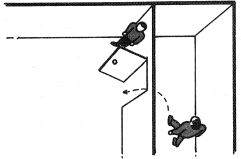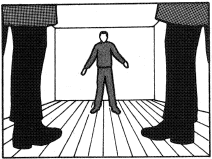Unorthodox Treatment
There are always occasions when you want to use some kind of unusual treatment: to give the situation a fresh look, to create shock, excitement or amusement, or simply to make it more interesting.
Camera treatment
Typical forms of visual treatment include:
• Pull focus (from one distance to another).
• Crash zoom. Zoom jumps.
• Overhead (through ceiling) shots.
• Low shots taken from ground level, or vertically upwards.
• Canted shots; tilting off horizontal to suggest instability.
• Vehicles racing towards the camera, apparently running over it. (Use an isolated camera, or shoot via a mirror.)
• Cameras clamped low on a traveling vehicle.
• Modified camera images, using diffusion disks, soft-edged filters, strong sky filters, star filters, multi-image filters.
Switcher treatment
• Superimposed images.
• Wipes.
• Outline generation (subject is converted to an outline).
• Silhouette generation (converting subject to a silhouette). Electronic treatment
Images modified electronically, to produce:
• Exaggerated or diminished tonal values (gamma adjustment).
• Exaggerated or diminished color (adjust saturation).
• Color suppressed, or converted to, for example, sepia.
• Picture ‘posterized’ (reduced to just a few tonal steps).
• Picture (or part of it) broken up into small squares (mosaic).
• Electronically softened picture.
• Chromakey used to insert pattern or texture to subjects.
• Color changes (chosen color substituted with another).
• Multi-image generation.
• Picture speed changes, from fast motion to slow motion, reverse motion, repeat motion, time lapse, pixilation, freeze frames, etc.
Sound treatment
Audio, too, can be manipulated to produce many unusual effects:
• duality changes (audio filtering; distortion).
• Reverberation (adjustable artificial reverberation devices).
• Pitch changes (from ‘chipmunk’ speech to slowed-down effects).
• Speed changes.
• Reversed sound.
• Repeated sounds (stutter effects).
Lighting treatment
A wide range of lighting equipment is available to produce unusual light effects:
• Flashing lights (e.g. ‘chaser’ lights, flashing patterns, lightning).
• Moving lights (e.g. mirror ball, moving pattern projectors, lasers).
• Light patterns (using ‘gobo’ stencils, slides, cast shadows).
• Color effects (color changes, color mixtures).
Overhead shot
An overhead view can reveal decorative effect, grouping and movement.

Alternatively, the overhead shot can give the audience a dramatic overall view, so that they can see the intruder behind the door, and the unsuspecting newcomer.

Ground shot
An extremely dramatic viewpoint that can be achieved by shooting into a low mirror or using a very low camera mounting, or staging the scene on an elevated area.

Canted shot
The canted (tilted) shot remains one of the most effective ways of conveying instability, fear, madness, etc.

